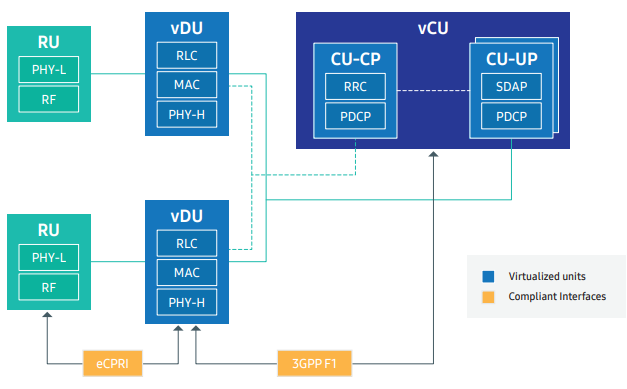vRAN is a new architecture enhancing the flexibility of Centralized RAN (C-RAN) by virtualizing the functions of basebands in a common resource pool made up of the Commercial Off-the-Shelf (COTS) servers located in a centralized Hub, allocating resources in a flexible manner according to traffic conditions.
vRAN = Virtual Radio Access Network
Why vRAN?
Maintaining mobile connectivity as the user transitions between cells is one of the most challenging tasks for the RAN, and operators want to minimize handovers. However, 5G can operate in very high frequencies, commonly referred to as millimeter wave spectrum, and while these frequency bands provide high throughput, they do so at the expense of coverage. For efficient 5G operations in these higher bands, the MNO will likely deploy many cells for more frequent handovers for mobile users.
At the same time, higher frequency bands also allow the use of broader bandwidth carriers, so gNBs need to handle considerably more traffic processing capacity compared to previous base stations. Dual Connectivity, which is widely used in current 5G networks, increases the system’s capacity needs, as devices may send and receive traffic from two different base stations. Instead of inefficiently processing the load on a distributed unit (DU), the centralized unit is a better option, as it is a more accessible site where resource pooling and sharing can better handle the task. For these reasons, 5G deployments are best served by a separated centralized unit (CU) that is more centrally located from the DU.

The network function virtualization and cloudification of vRAN, and its deployment at various scales spanning site, far edge, edge, and core clouds facilitate flexible and adaptive capacity management.
For instance, when more traffic is observed from some cell sites, or the number of UEs is observed to increase, vRAN allows the operator to dynamically change the cell capacities for those cell sites. Likewise, when less traffic comes from other cell sites or the number of UEs is observed to decrease, the corresponding cell capacities can be dynamically changed.
In summary, vRAN’s flexible and adaptive capacity management offers several benefits that would lead to avoiding over-provisioning of RAN capacity dimensioned for peak traffic demand. This also facilitates practical and affordable capacity scalability that avoids unnecessary vDU server investment.
Reference: Samsung Networks
